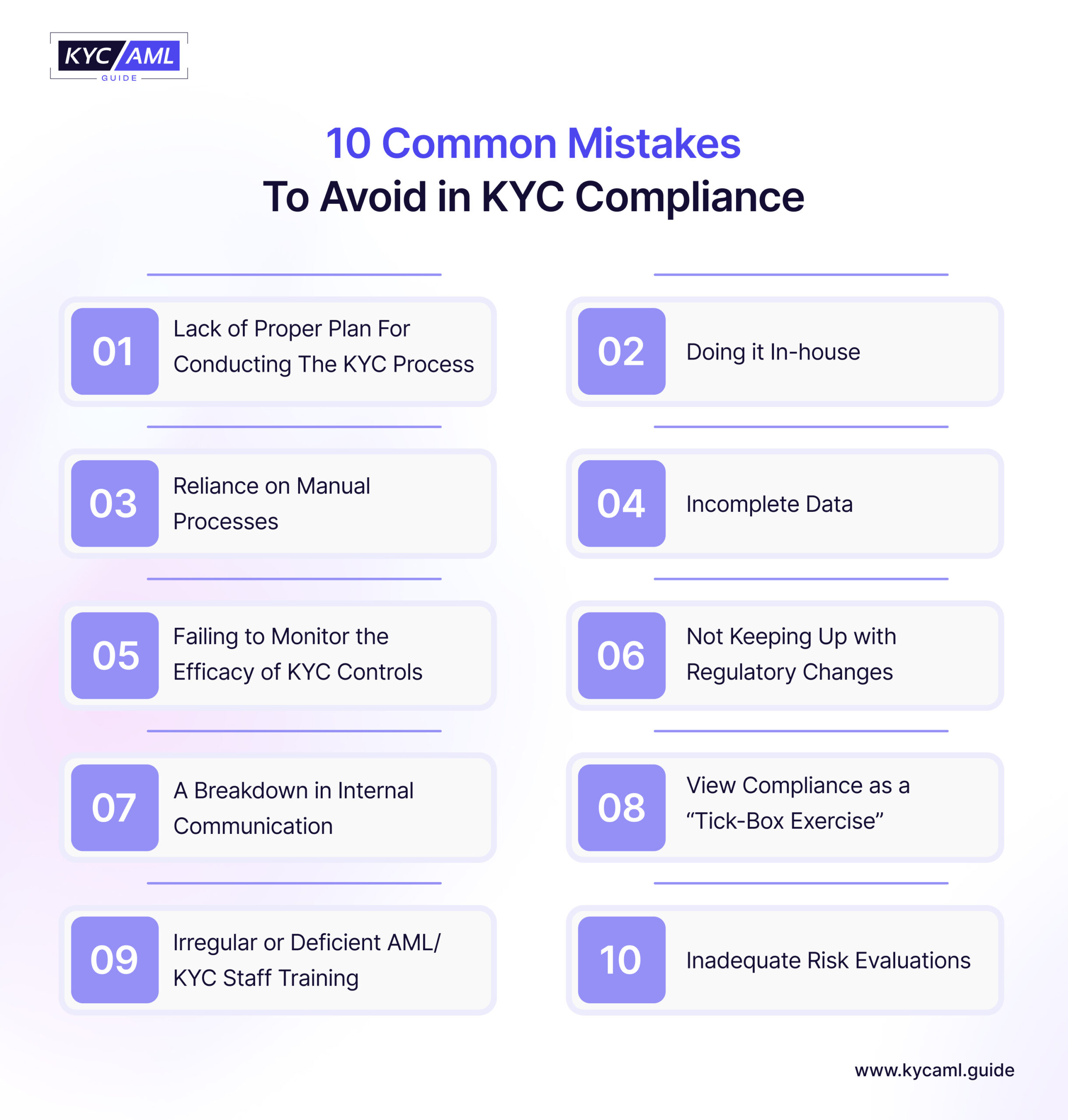The Top 10 common mistakes to avoid in KYC compliance are as follows

Lack of Proper Plan For Conducting The KYC Process
KYC is a complex process. It takes a lot of time. This can be exhausting for teams and customers. KYC requires you to collect multiple data about each customer and manage the customer onboarding process. It is critical for AML compliance. This is why a good KYC plan is essential. Before starting KYC activities, the company should prepare a detailed plan with relevant information, processes, resources, and schedules. The workflow for the KYC process must cover the key elements of coordinating compliance, business, and technical teams. KYC regulations can be successfully implemented if robust KYC plans exist.
Doing it In-House
In-house KYC compliance rarely works, and when it does compliance people get a bad reputation as “business inhibitors.” Few companies have the time, budget, and in-depth knowledge of KYC regulations to develop solid compliance. This makes it very difficult to ensure the necessary high protection of the company.
Reliance on Manual Processes
Manual processes can be costly due to human error and also in terms of employee time. However, financial institutions often waste valuable time and money on services that can be automated. Why waste time gathering documents when the process can easily be automated?
Automating data flows saves money and time and increases efficiency and performance by simplifying tasks. Thus, the researcher’s time spent on data extraction and cleaning can be used to identify and mitigate risk. Optimizing your available resources can strengthen your defenses against criminals seeking ill-gotten gains.
Incomplete Data
Data can be important, but what you do with it matters. Internal data gaps can hinder compliance efforts and insights into customer behavior. It also increases the risk of financial fraud. The importance of data cannot be underestimated. However, many financial institutions maintain and use incomplete customer data files. Missing or incomplete data allows criminals to exploit weaknesses in KYC regulations and AML systems to commit heinous crimes.
Failing to Monitor the Efficacy of KYC Controls
On the 21st of September 2020 over 2100 SARs sent to FinCEN by banks were leaked in media. Leaked reports containing nearly $2 trillion in transactions had shown how a portion of the world’s biggest banks has empowered wrongdoers to move illegal cash all over the planet. This sheds light on the illegal activities happening globally. Some banks have made it easy for criminals to launder their ill-gotten gains. Inadequate KYC regulations and transaction monitoring systems are detrimental to any financial institution. A lot of information can be lost if the efficiency of the KYC control system fails. Although artificial intelligence and machine learning are making KYC checks more efficient, cost is still a challenge for them.
Not Keeping Up with Regulatory Changes
New methods of detecting illegal financial transactions are emerging and risk takers are developing new ways to evade the attention of financial regulators. Despite all these, the KYC regulation will be effective against prohibited activities. Many record-keeping requirements are closed and outdated. Additional reporting requirements should be developed to prevent data collation. The only way to stay ahead of individuals and companies involved in fraud and illegal activities is to be aware of the latest AML and KYC trends and best practices.
A Breakdown in Internal Communication
The importance of KYC compliance is depicted by Internal communication. When everyone knows the new compliance requirements and KYC regulations the organization is better protected against negative audit surprises and damage from malicious actors. Also, compliance officers should not waste time on matters that are not their purpose. It is important to remember that breaches affect the entire company, so everyone in the organization should be able to prevent them.
View Compliance as a “Tick-Box Exercise”
KYC and AML compliance is often seen as a “tick-box exercise” that is often implemented annually or quarterly, or only done in preparation for audits. However, compliance is done to improve security, reduce risk, and protect corporate assets and reputation.
Irregular or Deficient AML/KYC Staff Training
KYC AML training should be ongoing and focus on topics that can be applied to everyday life. Training will cover all relevant areas and should be technology-based. Training should also include visual demonstrations of various AML best practices to improve retention. Companies that do not properly train their employees run the risk of making mistakes which can cause problems.
Inadequate Risk Evaluations
KYC risk analysis is a measure of risk. It assesses the customer or an organizational risk. Many companies calculate both risk factors because they are both important. Once you’ve collected customer data, you need to compile it. Once done, you can analyze the data and calculate the KYC risk score for each customer. If a user has a high-risk rating, you should keep them under strict monitoring.
Also Read: The Ultimate Checklist for KYC Regulations
Keeping The Balance
Maintaining Balance in KYC regulation and compliance is important as it avoids losing customers, fines, and your reputation. Try not to commit these common mistakes in KYC compliance by putting resources into individuals, innovation, and reliable information to allow you the best opportunity of getting crooks and safeguarding your image.





